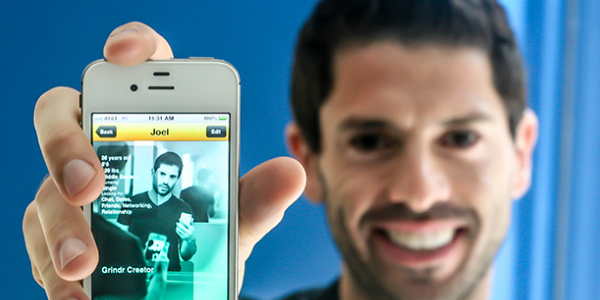The most arresting image in Joel Simkhai‘s PowerPoint deck, which was projected on a huge overhead screen in a big tent at C2 Montréal this week, was not a pie chart or a set of bullet points but a portrait of what may be the idealized Grindr user.
Naked, muscular, dark haired and shot in stylized black and white, the model’s image was a reminder that, even if most of its six million active users don’t exactly look quite like him, the key to its brand is making sure it focuses on the original problem the app set to solve: finding companionship on demand.
Grindr founder @joelsimkhai says a big priority in the app space is having a big enough…user base. #C2M16 pic.twitter.com/cNQrXdKVNu
— Marketing Magazine (@Marketing_Mag) May 24, 2016
“We probably have the least amount of features,” compared to similar kinds of apps, said Simkhai, even though he said he gets requests for more functionality from people he meets all the time. “I’m not in the business of adding features. People will ask me if I’ll add features and I’ll say, ‘It depends. Explain to me the problem you’re trying to solve.'”
According to Simkhai, this is probably the most dangerous mistake many other brands making apps tend to forget: that the original utility is what drives usage and loyalty, not additional complexity that may make an app look cutting-edge.
“You can waste millions and millions of dollars on advertising,” he told the C2 crowd, or they could save money by offering a form of value so powerful it attracts user-generated advocates and ambassadors. In Grindr’s case, one of the most notable ambassadors was the actor, writer and comedian Stephen Fry, who mentioned it on the British TV show Top Gear.
“He’s a gay guy and he realized that the service would have a lot more value if there were a lot more guys on it,” Simkhai said, adding he has personally taken on a similar role with driving app Waze. “I talk about Waze all the time, because I’m hoping you’ll put in all the traffic-related data so I don’t have to.”
In most cases, though, that value should be simple enough it can be relayed in a sentence or two. “I had lunch with someone the other day where they were trying to explain their app. It took about five minutes,” he said. “That’s way too long.”
And, while marketers may see part of their role as helping articulate the value an app can offer to a brand’s target audience, Simkhai suggested that too may be a waste.
“You cannot convince people they have a problem to solve,” he said. “That’s a recipe for disaster. When you talk about the problem, their eyes should light up.”
Grindr, which predates Tinder, was built for about $5,000 over a six-month period with only a designer and a developer, Simkhai said. Though he created Grindr before the app economy as we know it took off, he said too many companies failed to execute quickly enough. As proof, he asked how many of the C2 audience had developed an idea for an app. Most hands went up. Then he asked how many had actually brought it to market. Far fewer hands were raised.
If fear of the competition is an issue, Simkhai suggested brands not worry about it too much. “I sometimes get asked to sign an NDA to hear about someone’s app idea, but I guarantee you thousands of other people have already identified that problem and may have even come up with the solution. The key is to get it out.”
C2 Montreal runs through Thursday.











